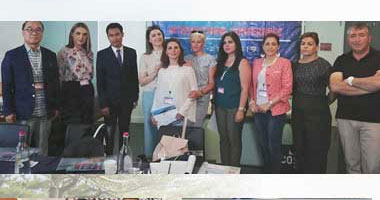Stop selling and start educating

Jason Sayen,Director of Business Development,
LK & Associate
In a world that is transparent, globally connected and where information is available at our fingertips, education has become a more important part of the sales process than ever before across all industries.Customers and clients now come armed with information after reading reviews, talking with friends and doing research online. Sales people these days feel like they are in defensive mode which makes it more difficult to sell the customer the right solution. Stop…take a deep breath and lets rewind.
Sales…circa the world wide web
I transitioned from an electronics installer into retail sales back in 1998 and before I even set foot on the sales floor, the company I worked for (Classic Stereo and Video) put me through PARA training. PARA, Professional Audio Video Retailers Association, was the industry’s first management association for independent audio retailers that provided training and business resources. PARA focused on the building blocks of retail sales like qualifying, the art of the demo and feature/benefit relationships. You see, up until the internet exploded with information, customers used to come to us to learn about the products and services we sold. We were the gate keepers of information.
So to clearly illustrate how simple the process was, customers would come to us for information. We would educate them on the products and services based on their needs (qualifying and feature benefit), blow them away with a demo (art of the demo) and close the sale. It was pretty basic blocking and tackling without many distractions other than battling over price against your competitor or something they found in a catalog…all of which were pretty easy to overcome.
Educating Ourselves
While going through PARA training, I learned how important it was to educate myself on my competition and the products I sold and didn’t sell. We would take trips to our competitors to act as a customer and study how they sold to us. Everything from how they qualified us (or didn’t), gave us a demo and how quickly they recognized that we were in their store. I also spent time learning about the products I didn’t sell. Since the internet wasn’t loaded with information at the time and their were no dealer portals back then, this meant reading past and current trade magazines that had product reviews and write ups. Subscribing to Crutchfield was a necessity as it was considered “the bible” loaded with all kinds of product information.
My company also invested heavily in our store displays, let us take home products for demo and had incentives for employees to purchase products at a discount so that we could experience them ourselves. Virtually every product we sold was set up in our showroom for someone to experience. This was all part of the education process.
Our manufacturer sales reps visited the store frequently. The managers made them accountable to spend time with all of the sales people, to educate them on the products, answer questions and give us tips on how to demonstrate the products to customers. They were a great resource and provided a value during their visit. The good ones would even educate us on the product category in general, not just about the product they sold.
Educating our customers
Reading online reviews, talking to friends and searching the web for information is not an education or experience…it’s RESEARCH. Customers now come to use armed with research and it’s our job to educate them on their research in order to properly recommend the products and services we have to offer. This is called qualifying which has been lost in today’s world of information overload. Sales people find themselves too busy to learn about other products and figure that they will just log onto a portal when they need the information. Too many times customers come to us with a list of what they want and because we don’t want to lose the sale, we say yes to everything and figure out how to make it work. This leads to a bad experience, is bad for the industry and starts a damaging sales cycle that is tough to get out of.
Qualifying is simply the process of assessing the customers needs to determine the correct solution. If you ask enough questions, you will eventually get to the true answer of what the customer wants. Educating yourself is a key component in the qualifying process. Asking questions narrows down the customers needs but understanding how all of these products work separately and together is key. Even if you don’t sell these products, you need to understand how they work and don’t work together to better educate the customer. You can’t just tell the customer that the product isn’t good because the 100 reviews that they read online tell him otherwise.
IOT products and brand names like SONOS and Nest have done an incredible job at creating more awareness of our product category. So much that customers come asking for this product by name which is great. But in some cases, this is not what the customer actually needs.
When I worked for Savant and gave demonstrations at our training facility, almost every customer would ask about SONOS and Nest. My first response was not to talk about our streaming music solution or climate solution but rather ask them a few questions.
“Do you have SONOS/Nest in your house now?” “Does the project require wireless music or are we able to run wire?” “Do you like the brushed aluminum object on the wall or would you rather not see it at all?” “Are you looking for streaming music or SONOS?”
Usually the last question would finally get me the answer I was looking for which was “We want streaming music!” Now, had the customer answered me differently and said that they currently have SONOS and or in their new project they need music to be wireless, I would then discuss the options of Sonos integration. Also since I had both SONOS and Nest in my house, I could speak to the pros and cons of the product and the experience, which is key when handling objections. Telling a customer that the product they are requesting is bad or won’t work is not handling an objection…it’s giving your opinion.
I could go on and use other examples like Alexa, Ring and others however the point is that you have to ask key questions to find out why they are asking for this product. Price can be a major factor as well which is why they are requesting these brands. Through qualifying, you may also realize that this isn’t the customer for you which saves you money in the long run. Maybe they know exactly why they want it but most of the time it’s just because the brand has done a great job at getting in front of the customer and the good news is that because of that, now the customer is in front of us.
The Big Opportunity
Because of the great job that brands have done marketing their products, we have a bigger opportunity to more customers than ever before. Customer don’t just buy products, they buy experiences. In the case of home automation, it’s an experience that they wake up to every morning. Gathering information online will not help them understand the experience and even a series of questions through qualifying won’t help them understand the experience. Educate yourself so that you can explain exactly how that experience will be. Set the correct expectations up front for success at the end. I believe this is why CEDIA wanted to change the term “integrator” to “technologist”. Customers need help making sense of all of the technology which means you have to become an expert on what’s available.
Even if you don’t sell Nest, Sonos, Alexa or Ring, have the products set up at your home or office to try them out. They are all very inexpensive however the education experience you will get will pay for the cost over and over. Education doesn’t just stop with product knowledge either. Hold your reps accountable for training your team. Invite them to your weekly meetings even if it’s just for a half hour. Discuss up front what you want them to talk about so that there is value added to the meeting.
Although PARA is no longer around, there are new resources at our disposal to help sharpen our skills in selling and installation. Maverick Integration created Maverick Technical Institute which offers classroom and hands-on career training for low voltage technicians. The school has gotten some amazing reviews and I consistently get calls from dealers asking for good technicians. For the sales people that are looking to hone their presentation skills, the CEDIA Outreach Instructor Program is a great way to get in with architects, designers and other skilled trades to sell our services. These resources are very inexpensive and provide a tremendous value. CEDIA is also bringing back it’s regional events which will also be a great resource for the industry.
Subscribe to Industry Era
News
A look at the history of public media in the U.S. as Republicans target federal funding
Pilot and 2 young daughters survive the night on airplane wing after crashing into icy Alaska lake
Columbia Planned Tighter Protest Rules Even Before Trump Demanded Them
US House Speaker Johnson says Congress can 'eliminate' district courts
Texas lawmaker Jasmine Crockett defends 'hot wheels' comment about Gov. Greg Abbott
Vance to join wife for Greenland trip on Friday, suggests global security at stake
Columbia student protester can’t be detained for now as she fights deportation, judge rules
Tesla Stock Rises for 5th Straight Session—Watch These Key Price Levels
Kroger countersues rival Albertsons after demise of $25 billion merger
The Best Deals From Amazon’s Big Spring Sale (and Across the Internet) This Week
Asia markets trade mostly higher after Wall Street extends gains on hopes of softer Trump tariffs










